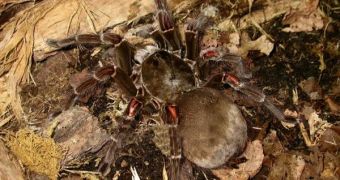Meet the Goliath bird eating spider, also known as the birdeater (Theraphosa blondi), a member of the tarantula family. Despite its name, it finds it pretty hard to hunt down birds, but was observed to trap and eat fully-grown mice with relative ease, which is impressive for a spider of its size. According to naturalists, it's one of the most remarkable creatures ever to walk on the face of Earth, on account of the defense mechanisms it employs, and the size it evolved to over millions of years.
The creature gets its name from Victorian Age explorers of South America who witnessed the rare event of the T. blondi eating a hummingbird, and brought back news of this to the Western world. Since then, however, sightings of this type of actions have been very few.
It has some of the largest fangs ever encountered in spider species, 1 to 2.5 centimeters (0.4 to 1 inch) in length. This means that it can easily penetrate the human skin. But there's no need to worry. Even though the birdeater carries venom, it's relatively harmless, and the effects of a bite are similar to those from a wasp sting. Furthermore, this type of tarantulas rarely bite humans, and do so only when they are directly threatened. And even then, only at times do they insert venom into their bite. Most of the time, they leave what scientists call a “dry bite,” where only the marks of the fangs remain.
Its body is simply huge in the arachnid world – 30 centimeters (12 inches) from the tip of the legs. It can also reach a weight of 120 grams (4.2 ounces), which makes it very heavy for a spider. It uses this to its advantage, by employing its body weight in its effort to dig holes for itself. It is a deep-burrowing species, because deep layers in the ground allow it to sense prey approaching. Its eyesight is not the best among spiders, but it does have a natural instinct for detecting vibrations made by other animals walking.
Goliath bird eating spiders mostly live in the rain forests of northern South America, and rarely attack humans. Females can live for as much as 15 to 25 years, while males only have an estimated lifespan of 2.5 to 3 years. Both genders have strong natural defenses, including a hiss that they make when feeling intruders, their fangs and bites, as well as the ability to kick urticating hair at enemies. This type of hair is extremely dangerous, as it produces grave lesions in the skin and lungs. People who have gone through the experience say the feeling resembles that of having shards of glass in your skin.
In their native areas, the creatures are hunted by Amerindians, and eaten as delicacies. The most sought after parts are the 100 to 400 eggs that the female deposits after each mating. Because of the threat the spiders' hairs pose, these people developed ingenious ways to hunt them, so as to avoid accidents. At this point, the birdeater is generally considered to be the largest spider in the world.

 14 DAY TRIAL //
14 DAY TRIAL //